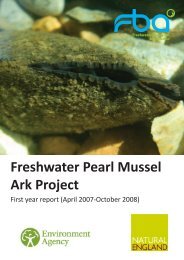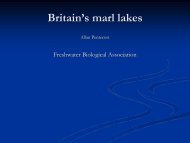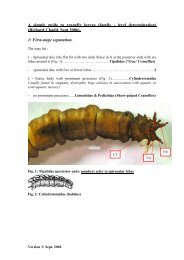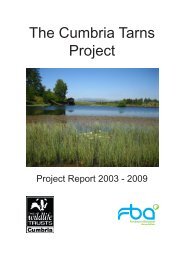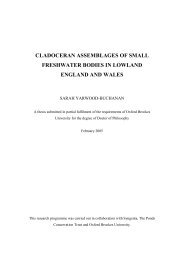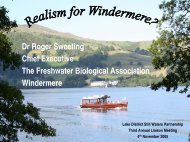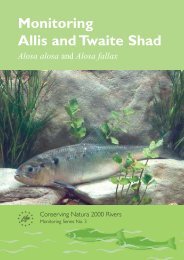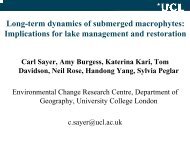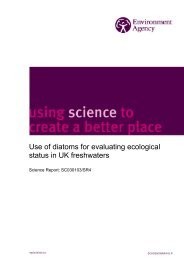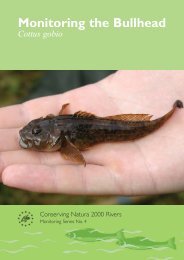Managing Woody Debris - FreshwaterLife
Managing Woody Debris - FreshwaterLife
Managing Woody Debris - FreshwaterLife
Create successful ePaper yourself
Turn your PDF publications into a flip-book with our unique Google optimized e-Paper software.
3. River Trent at Wolseley Bridge, Staffordshire<br />
Background Staffordshire Wildlife Trust<br />
(SWT) owns and manages the site. The<br />
River Trent had been engineered into a deep<br />
trapezoidal channel and effectively<br />
disconnected from its floodplain.<br />
Objective To re-profile 340 metres of the<br />
River Trent along the inside of a large<br />
meander to help kickstart natural<br />
geomorphological processes including<br />
River profile before works<br />
erosion and deposition and promote realignment<br />
with its floodplain. To use the scheme as a demonstration of best practice to<br />
inspire similar work elsewhere.<br />
Description The river re-profiling has<br />
been very successful. Shortly after<br />
completing the works a ‘happy accident’<br />
involved the input of a mature beech tree<br />
which formed LWD in the restored channel.<br />
Liaision with the Environment Agency<br />
ensured that the LWD could be left in and<br />
monitored.<br />
Assessment Monitoring of the LWD over<br />
a three year period has shown that (i) a<br />
short-term erosion pocket was created<br />
shortly after the beech tree entered the<br />
channel. The volume of the erosion pocket<br />
was approximately one and half times the<br />
volume of the submerged timber when the<br />
LWD enters the channel river was bank-full. It has since stabilised;<br />
(ii) No part of the LWD has moved more<br />
than twenty metres downstream; (iii) The LWD has gradually accumulated smaller<br />
pieces of woody debris and has become surprisingly stable; (iv) common sandpiper,<br />
grey wagtail, kingfisher, hornet and otter are<br />
among the species recorded using the LWD as<br />
a foraging, perching or spraint site.<br />
Project Partners SWT, Environment Agency,<br />
Middlemarch Environmental<br />
Cost Part of £21K project<br />
More info n.mott@staffs-wildlife.org.uk<br />
18<br />
...after reprofiling<br />
CWD accumulating




